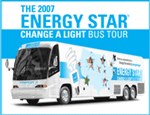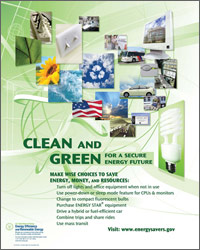Thanks to Martin Bromley for responding to my post about sharing energy efficiency information in honor of Energy Awareness Month by submitting the following article. Martin notes that although the article refers to “business” energy waste, the concepts discussed apply to other organizations such as government offices, colleges, schools, etc. Please note that reference to Martin’s software, Energy Lens, is for informational purposes only and should not be construed as an endorsement by GLRPPR or WMRC.–JS
Why Energy Monitoring is Critical to Reducing Business Energy Waste
By Martin Bromley
Monitoring energy consumption is vitally important for businesses that want to cut their costs and environmental impact by saving energy. This article gives an introduction to energy monitoring, and explains why it is so important for business energy management.
“Energy monitoring”, or “monitoring and targeting”, is the process of analyzing energy-consumption data to find signs of waste (opportunities to target), and to track changes in energy consumption as time goes on and as energy-saving measures are implemented.
Energy monitoring goes hand in hand with energy management: the process of controlling and conserving energy consumption within an organization. “You can’t manage what you don’t measure” has become a real cliché in the energy-management industry, but it does hold a lot of truth: energy monitoring brings measurement into the process of energy management, and makes it hugely more effective as a result.
Monitor energy consumption to see if you are improving:
Energy monitoring enables you to see if your energy efficiency is improving as time goes on. A big part of energy management is implementing energy-saving measures, and energy monitoring enables you assess how well your energy-saving measures are working.
For example, you might decide to try changing the power-management settings on staff computers, to reduce their energy consumption when they aren’t in use. By analyzing your energy-consumption data, you should be able to tell whether or not such a measure has helped to save energy, and you should be able to get an indication of how much energy it has saved. This helps you to decide whether an energy-saving measure is worth pursuing further, or whether it’s time to focus your energy-management attention elsewhere.
Energy monitoring will also enable you to prove the energy savings that you’ve achieved — if your hard work has hammered down energy consumption at your business, you’ll want to be able to prove it!
Monitor energy consumption to find energy waste:
Energy monitoring can also be a very effective way to find out when and where your business is wasting energy. Traditional weekly or monthly meter readings are little use for this, but the detail contained within modern energy-consumption data such as 15-minute or half-hourly data makes it easy to identify specific days and times when the business is routinely using energy unnecessarily.
For most businesses, the quickest way to make big energy savings is to ensure that equipment is switched off when it isn’t needed. You might think that this is easy: just make sure that people switch things off. However, it’s rarely that straightforward. If a light is left on it’s usually clear to see, but the energy consumption of other types of equipment is often much less obvious. Also, unless your building is very small, it can take a long time to check all the equipment that should be switched off. Things are further complicated by people working on after you’ve gone home, and by equipment that’s controlled by timers (you need to keep checking that the timers are set and working correctly).
If you have good quality energy data (such as 15-minute or half-hourly data), analyzing it once a week or once a month will make it easy to see how much energy is being used throughout each working day, and when the building is closed. You can check whether staff and timers are switching things off without having to patrol the building day and night, and, with a little detective work, you can usually figure out who or what is causing the energy wastage that you will inevitably find. A good understanding of your energy-consumption patterns will also help you to make informed decisions about where best to focus your energy-management attention, enabling you to hone in on the biggest, easiest energy savings first.
Getting started with energy monitoring:
If you are not already monitoring your energy consumption, you are almost certainly wasting energy that is costing your business, and costing the planet.
The good news is that it’s easy to get started with energy monitoring: once a week (or once a month) spend a little time analyzing your energy-consumption data from the previous week (or month). Look for signs of waste and take steps to ensure that such waste doesn’t happen again.
Wise investments into energy monitoring should pay for themselves many times over with the energy savings you’ll achieve by making your business more energy efficient. So why not get started today?!
About the author, and further resources:
Martin Bromley is a keen advocate of energy monitoring, and one of the main people behind Energy Lens: a software package that makes it easy to turn energy-consumption data into energy monitoring charts and tables that are invaluable for energy management.
If you are interested in saving energy at your organization, please do visit the Energy Lens website at http://www.energylens.com/ for more information and a freely downloadable trial of the Energy Lens software.
Article Source: http://EzineArticles.com/?expert=Martin_Bromley; reprinted with author’s permission.
 Wisconsin’s energy efficiency and renewable energy initiative, is currently offering instant cash-back rewards on select Energy Star qualified compact fluorescent (CFL) light bulbs. The promotion began on October 1, and while supplies last, Wisconsin residents can buy the CFLs for as little as $0.99. For more information on participating retailers, contact Focus on Energy at 800-762-7077 or see the campaign web page. The campaign site also includes a nice little calculator to estimate your yearly savings based upon the number of standard bulbs you replace with CFLs.
Wisconsin’s energy efficiency and renewable energy initiative, is currently offering instant cash-back rewards on select Energy Star qualified compact fluorescent (CFL) light bulbs. The promotion began on October 1, and while supplies last, Wisconsin residents can buy the CFLs for as little as $0.99. For more information on participating retailers, contact Focus on Energy at 800-762-7077 or see the campaign web page. The campaign site also includes a nice little calculator to estimate your yearly savings based upon the number of standard bulbs you replace with CFLs.
 On October 3, 2007, U.S. EPA Administrator Stephen L. Johnson kicked off a 10-city, 20-day Energy Star Change-a-Light Bus Tour at Disneyland. EPA and the Department of Energy are sponsoring the tour to raise awareness of the benefits of energy efficient lighting choices. At each tour stop, an outdoor education center will be set up with interactive displays on the importance of our lighting choices, how to use and dispose of compact fluorescent lamps (CFLs) responsibly, and the connection between our personal energy use and our climate. According to EPA, Energy Star qualified light bulbs use 75 percent less energy than standard incandescent bulbs, and last six to ten times longer. See the
On October 3, 2007, U.S. EPA Administrator Stephen L. Johnson kicked off a 10-city, 20-day Energy Star Change-a-Light Bus Tour at Disneyland. EPA and the Department of Energy are sponsoring the tour to raise awareness of the benefits of energy efficient lighting choices. At each tour stop, an outdoor education center will be set up with interactive displays on the importance of our lighting choices, how to use and dispose of compact fluorescent lamps (CFLs) responsibly, and the connection between our personal energy use and our climate. According to EPA, Energy Star qualified light bulbs use 75 percent less energy than standard incandescent bulbs, and last six to ten times longer. See the  October is Energy Awareness Month. See the
October is Energy Awareness Month. See the  Applications are now available for the 2008 Pennsylvania Governor’s Award for Environmental Excellence. The award is open to any Pennsylvania business, government agency, educational institution, nonprofit organization, individual or farm that has created or helped to develop a project that promotes environmental stewardship and economic development in the state. The deadline to submit projects for 2008 awards is Monday, October 15, 2007. You can download an application and view detailed summaries of past winning projects on the
Applications are now available for the 2008 Pennsylvania Governor’s Award for Environmental Excellence. The award is open to any Pennsylvania business, government agency, educational institution, nonprofit organization, individual or farm that has created or helped to develop a project that promotes environmental stewardship and economic development in the state. The deadline to submit projects for 2008 awards is Monday, October 15, 2007. You can download an application and view detailed summaries of past winning projects on the